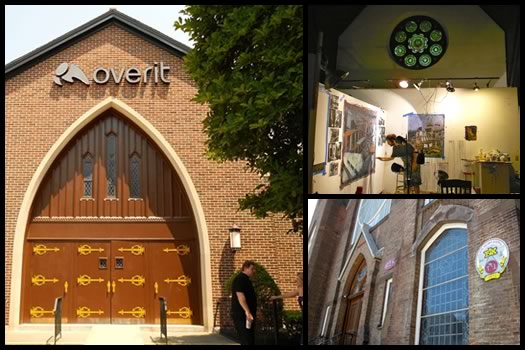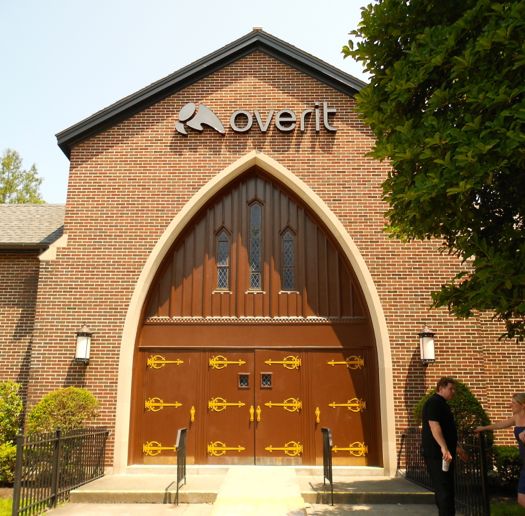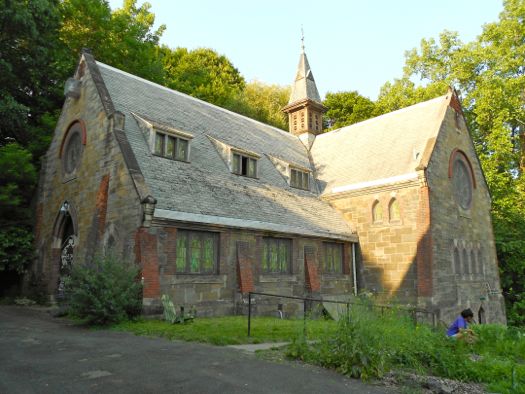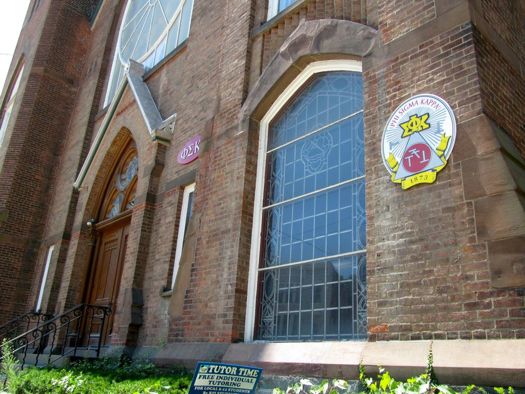New lives for old churches

Many Capital Region churches have closed in recent years due to dwindling congregations, parish mergers, or financial difficulties. And when the congregations go, they leave behind some grand buildings. So what happens to these empty churches?
The issue has been in the news a lot lately because of the controversy surrounding St. Patrick's in Watervliet and a proposal on the table to turn St. Joseph's in Albany into a brewery.
But there are lots of old churches in the Capital Region that have already found new lives. Here's a look at a few.
Then: St. Teresa of Avila in Albany
Now: Home of Overit Media

The former St. Teresa of Avila Church was closed by the Catholic Diocese of Albany in 2009 and merged with a neighboring parish. This past January the vacant church and its rectory next door became the headquarters for Overit Media, a web design and development/marketing company.
After a merger with Portfolio PR Group, the company found itself in need of a bigger space. "We wanted it to be efficient, functional, and more beautiful that a commercial building," says president and CEO Dan Dinsmore. And the St. Teresa's fit the company's list of desires.
The rectory now houses offices and the church is in the midst of becoming the company's multimedia center with a production area for designers, animators, developers, and a state-of-the-art sound studio.

What were the challenges to the community in re-purposing the building?
Nicole Messier, managing director of Overit, says there really weren't any. "We were expecting at least a little backlash from the community, but there was none. Most were happy to see the church being used."
What were the challenges in transforming the building from a church into something new?
"No pun intended, but a lot of it isn't 'altar-ed,'" says Dinsmore. He says the building was perfect for the company, with acoustics and open space that they could mold into what they needed, and keeping the integrity of the building intact was important to them. "We cleaned up the outside, but reused everything inside we could. You could literally take down the walls we've put up and turn this space back into a church."
How does new meet old in this space?
Overit has combined a state-of-the-art building with 90-year-old stained glass windows, pillars, and cathedral ceilings. Even their desks, floorboards and baseboards are made entirely of the church's wooden pews.
Then: Woodside Presbyterian Church in Troy
Now: The Contemporary Artist Center

The Contemporary Artist Center moved into the former Woodside Presbyterian Church in 2009 after a year of renovations. The historic church was built in 1868 and has watched the great industrial history of the area from its hilltop view. Now it has become a workspace and year-round artists' retreat. Over one hundred national and international artists travel to Woodside each year to create, exhibit, and perform their work.
The church hall is now workspace and housing for the artists, and the church itself is space for exhibitions and performances throughout the year.
The CAC has been able to rally support from the community for voting in grant contests. And when they won the grant, the center hosted a neighborhood-wide party to celebrate. They also host a barbeque for the neighborhood each year.






What were the challenges to the community in repurposing the building?
The last congregation moved from the parish of their own volition in 2003, so there were no conflicts over the space. "The building was just reaching that tipping point between bringing down or building up the community," says executive director Hezzie Johanson. "So I think most people were glad to see it being used again."
What were the challenges in transforming the building from a church into something new?
The church hall was given a kitchen area and an upstairs for the artist housing. But the renovations needed for the church were minimal. Stonework needed to be enforced, modern lighting fixtures put in, and most importantly, restrooms still need to be installed. The church building has never had restrooms or running water in the facility.
How does new meet old in this space?
"This church has always been a beacon to the community, and that's what churches are supposed to do -- bring the community together," says John Johanson, project manager for the center, "and we're trying to keep that alive."
Then: St. Francis de Sales in Troy
Now: RPI's Phi Sigma Kappa fraternity house

In 2009 when the closing of six Troy churches was announced by the Albany Catholic Diocese, St. Francis de Sales was the first to close its door. Two years later, the doors re=opened for RPI's Phi Sigma Kappa fraternity. The rectory now houses students and the church space is available for community meetings and events. Together with their alumni administration, the brothers plan to keep the building as a gathering space for the neighborhood.
What were the challenges to the community in re-purposing the building?
"[The] biggest effort was not the renovation of the building, but building community support," says Phi Sigma Kappa's alumni association president Paul Marano. He says since St. Francis de Sales was the first church to close in 2009, many people were upset that the church was closing, but not at the fraternity for moving in. There were concerns about noise control, parties, or just not mowing the lawn or maintaining the property. But he says the fraternity hosted open forums and worked closely with the community to share their plans and soothe some fears. It also helps that they have a dry house policy.
"These buildings are over 140 years old and we try to be sensitive to that," says Marano. "We had an open house in the fall so people could walk through the building, their old parish, and see that we're taking good care of it. And we'll continue that once a year, we want to maintain a strong connection with the community."
What were the challenges is transforming the building from a church into something new?
As far as construction goes, no major work was needed. The fraternity kept the church itself as is, but has future plans to remove some the pews to allow for a more versatile community space. Other than that, all that was added to the buildings were small necessities such as fire alarm systems, new bathrooms, wireless internet -- and, of course, a big screen TV.
How does new meet old in this space?
The church still maintains its role in the neighborhood as a gathering space, where Marano says just last week a family from the neighborhood used the meeting room downstairs from the church for their 1-year-old's first birthday party. And the alumni association also plans to begin a neighborhood grant program to better help the community with projects such as house painting and keeping Prospect Park beautiful.
And the rectory of St. Francis de Sales' hasn't been re-purposed much at all; it once housed 5 or 6 priests living in brotherhood -- now it houses 24 fraternity brothers.
Then: Apostolic Pentecostal Church in Rensselaer
Now: home of Cathedral Sound

In 1975, the Apostolic Pentecostal congregation that occupied the church on the corner of Central Ave and 5th Street in Rensselaer grew too large for its sacred space. It moved to a larger church and Pat Tessitore moved in. Thirty-seven years ago, long before it was fashionable to re-purpose old churches, Cathedral Sounds Studio opened in the former church and has been producing audio for musicians, television and radio commercials ever since.
What were the challenges to the community in re-purposing the building?
Tessitore had to get permission from the city to open his business, and originally, there was some opposition. The congregation that originally occupied the church left on their own, so there was no hard feelings there. But some people were a little unclear about what a sound studio does.
"A lot of people were opposed immediately because they thought there'd be a lot of noise, but they didn't understand that the purpose of the studio is to keep the noise in. Once I explained that, we were fine," said Tessitore. The city was happy to see the church being used and the town was happy to see a business come into the community.
What were the challenges in transforming the building from a church into something new?
Tessitore says the building was a perfect fit for his crew. It was off the beaten path yet still close enough to the train station to get people in from New York City. As for the sound quality, it fit all their criteria. Tessitore explains that, back before microphones, churches had to be built acoustically correct to project the voice of the minister. They didn't have the technology to amplify, so each building needed to be designed so everyone in the congregation could hear the voice on the altar. That meant the only thing Tessitore had to do to perfect the acoustics in the church was install some sound deadening boards on the wall. He also moved to electric heat because the old furnace was too noisy.
How does new meet old in this space?
A structure from the early 1900s is now rigged with some of the newest digital technology available. The 30-foot gabled ceilings and space of the structure enhance the recording process, aided by Tessitore's equipment. But while some studios go for flare these days, Tessitore says his studio "takes you back to the early days of the church. It's very warm, homey, and comfortable. People like that environment."
Support for re-using old churches
Joe Fama, from the Troy Architectural Program, has been championing the reuse of Troy's churches for years, especially since six Catholic churches were closed in the area in 2009. Of the six, three already have new lives. St. Francis de Sales as the frat residence, St. Paul's on 12th Street is now an activity center for Unity House daycare, and St. Jean Baptiste on 3rd Street is in talks to become a marketplace.
"Keeping these buildings working is the best way to save them," says Fama. "Let's get to these while it's a real estate deal and before it becomes a crusade."
Real Estate Week:
+ Living in downtown Albany: a look at the growing options
+ What $175,000 buys you in the Capital Region
+ What $225,000 buys you in the Capital Region
+ What $350,000 buys you in the Capital Region
+ A home where you don't have to turn on the heat
+ The ___est neighborhoods in the Capital Region
Earlier on AOA:
+ The 7th Ward House, a former Baptist church now serving as a home and gathering space
+ The collapse of Trinity Church
+ Contemporary Artists Center at Woodside
last four artists photos at Woodside courtesy of CAC
Hi there. Comments have been closed for this item. Still have something to say? Contact us.
Comments
here's another" http://www.artscenteronthehudson.com/
... said Sally on Jul 14, 2012 at 11:36 AM | link
I'm all for reusing old churches. It's always sad to see a closed building no matter what it was for. Consider it recycling. Why put money in to building when there is a building you can use?
... said Wendy McLaughlin on Jul 14, 2012 at 4:31 PM | link
Its surely not on purpose, but the words "over it" appearing atop the entrance of a former Catholic church sums up so perfectly my feelings about that particular religion.
... said Elizabeth on Jul 15, 2012 at 9:41 PM | link
I am in favor of renewing or repurposing these buildings, however, I would prefer that they have ample opportunity to remain centers of faith. There are several new faith communities (e.g., Buddist, Muslim, and Christian) in the area. Many of these are formed by immigrant and minority groups, that do not have the same financial resources available to buy and rehabilitate these facilities. I would love to see some form of privately funded grants for such an endeavor.
... said Susan on Jun 6, 2013 at 12:10 PM | link